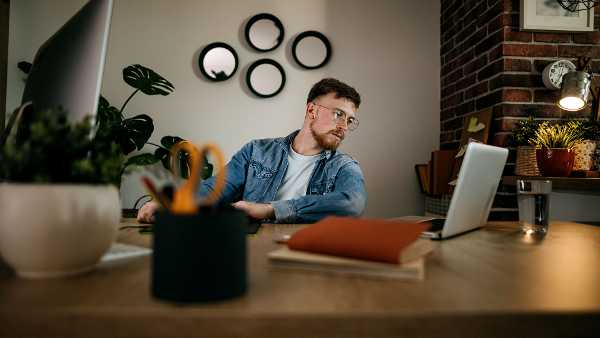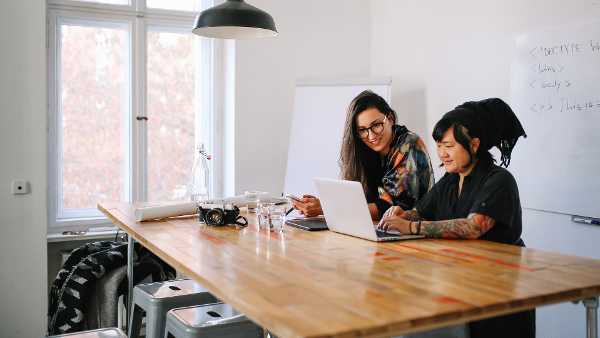Protect your work with intellectual property

- Sergej Schuurman
- Background
- 31 October 2022
- Edited 9 September 2025
- 9 min
- Rules and laws
You can protect new ideas, creations, concepts, and inventions with intellectual property rights. Read how this works and what you can do to prevent infringement of these rights.
New laws and rules 2026
Make sure you know what's coming.
Have you discovered misuse of your work? Then act as soon as possible. First determine which intellectual property rights (IP rights) you can draw on. Then decide if it is worth countering the misuse. Even if you have an exclusive right, such as patent right, legal proceedings are costly and time-consuming. It is often wise to engage a specialist to determine the best course of action.
Read more below about the most common IP rights, the laws that protect you, and the actions you can take in case of abuse.
- Copyright
- Design rights
- Trademark rights
- Patent
- Trade Names Act
- Trade Secrets Protection Act
- Protecting ideas and concepts
Copyright
If you write a text or piece of music, or create an illustration, photograph, or video, it is automatically copyrighted. You do not have to do anything or register anything for that to happen.
Copyright only applies if the work is original and if characteristics of the creator can be recognised. If someone uses your work and pretends it is their own, this is called . Copyright is valid until 70 years after the death of the creator.
Even short pieces of text can be subject to copyright. A quote is a short sentence or statement. If a quote has an original character or a personal creative stamp from the creator, it is subject to copyright.
Exception
A citation is also a short piece of text. You may use a citation without permission so long as you include the source and the author's name. A citation must be relevant to the content, and you may not cite more than is strictly necessary. The citation right is an exception to copyright law.
Prevent misuse
Once your work is public, it is difficult to prevent someone from misusing it. When publishing, include your name and date to discourage misuse. Indicate that the work may not be used without permission or acknowledgement of its source. This is how you report that you are the creator of the work. You can also use the copyright sign ©. This has no legal basis in the Netherlands but it serves as a deterrent.
Registering your work in the of the Benelux Office for Intellectual Property gives you proof that you are its creator. Doing that will help if you get into a legal dispute with the party who is misusing your work.
Taking action against infringement
- Is someone using your photo on a website or copying all or part of a publication written by you? If so, this may infringe your . This also applies even if someone makes minor adjustments to your work.
- This is what you can do
- Contact the party who is using your work without permission. Request that the copied work be removed or rectified. Specify exactly what text, music, photo, or illustration is involved. Also specify a deadline by which you want the work removed.
- Negotiate with the abuser to find a financial or other solution without involving the court. For example, you might transfer the copyright in return for payment, or grant the right of use.
- Are written materials on websites involved? Report this via Google . If the notification is justified, Google may remove the text that has been copied from its search results. You can also report infringement to Centraal Meldpunt Nederland, the reporting centre.
- Does the person misusing your work refuse to cooperate? Get legal to assess whether going to court is feasible. A legal process costs a lot of money and time. If you go to court you can ask for compensation for the income you are losing. Make sure you can clearly show the amount you have lost.
Design rights
Design rights protect the shape, appearance and configuration of products. Design rights are also known as industrial design rights. A design can be two-dimensional or three-dimensional, such as a pattern for clothing or the design of a household item.
Design rights protect appearance. Think of colour, outline, shape, and use of materials. The work must be new and have its own character. Technical function is covered, not by design rights, but by patent law.
Prevent misuse
To protect styling, a design, or a concept, you need to register it. The protection is not automatic. After you have registered the design with the , you have the exclusive right to use it.
You hold that right for an initial term of 5 years. After that, you can renew it for up to 4 more terms of 5 years each. This applies within the Benelux. You can also register the design so that it is protected Europe-wide or globally.
Taking action against infringement
If someone puts something on the market that looks almost the same as something you have protected, they are infringing on your exclusive right.
This is what you can do
- Negotiate with the party that has misused your work. As the design holder, you can transfer your design right for a fee. You can also license your design right for a fee. That means that someone will pay to use it for a certain period.
- Whether there has been an infringement is often about the details. This makes things more complicated. Engage an intellectual property lawyer. They cn also assess whether it makes sense to start legal proceedings.
- Ask the court to ban use of your model. The court will look at whether the designs are similar, and whether they make a different overall impression. If the court determines that there are just a few differences, it will usually find that there has been an infringement. If it determines that there is a different overall impression in each case, it will usually not rule in your favour.
Trademark rights
A trademark is a sign that you use to distinguish products or services from those of your competitors. It can comprise words (wordmarks), but also a logo (a pictorial mark), a certain colour or shape, or even a sound.
Prevent misuse
Trademark rights do not arise automatically: you must register them with the . You register them for the Benelux, for Europe, or globally. The more extensive the protection, the higher the cost. You have the exclusive right to use your trademark for 10 years. You can extend this indefinitely.
You register a trademark for different classes of goods and services. The more classes you do this for, the more extensive the protection, and the higher the cost. You can also use the services of specialised trademark agencies to register your trademark. They will help ensure that your trademark is recorded correctly.
Taking action against infringement
Infringement occurs when a sign is identical or similar to the registered trademark and is used for the same products or services. It also occurs if use of the sign is bad for the brand, damages its reputation, or creates false associations. Or if someone benefits from association with the brand for no good reason.
This is what you can do
- Try to reach an out-of-court settlement with the party who has misused your work. Make a mutual financial settlement or get the other party to withdraw the goods, supplies, or depictions in question.
- If you fail to reach a settlement, you can enforce a ban on using the trademark through the court. You can also demand other measures through legal proceedings. You might have assets seized, for instance, or claim damages. If there is infringement, bring in a specialist.
Patent
Patent rights help you protect a technical product or production process. You prohibit someone else from using your invention commercially for a certain period of time. You have an exclusive right to what you have developed.
Prevent misuse
A patent is applicable after , and patent protection is granted if the invention meets 3 criteria. It must be new, inventive, and original. In addition, you need to be able to apply it industrially.
Once you apply, it takes about 18 months until you have a patent. From then on, your invention is protected for up to 20 years. You apply for patents on a country-by-country basis. For the Netherlands, you apply for a patent at Octrooicentrum Nederland. You can also apply for a European , protecting the ownership of your innovation and enforce it in 17 EU countries.
Take action against infringement
If someone copies your patent-protected invention, they are infringing on your exclusive rights.
This is what you can do
- Ask them to stop. Let them know what you will do if they persist. This often serves as a deterrent. Take action as soon as possible if you discover or suspect infringement.
- Negotiate together to come to a resolution. This will save you a time-consuming and costly legal process. Perhaps you can work together with whoever has infringed on your rights.
- Grant them a licence to use your patent, so they can continue to use the invention for a fee. This can benefit both parties.
- In the worst case, you can start legal . You can require the abuser to stop the infringement, destroy the stock or withdraw the products from sale. You can also claim damages.Seek advice from a patent or other specialised lawyer.
Trade Names Act
You use a company name to distinguish your business. A company name is officially known as a trade name. The Trade Names Act (Handelswet) protects trade names. It also sets out rules that your company name must comply with.
Prevent misuse
The right to your trade name takes effect from the moment you start actually using it. For example, when you use it in advertising, on invoices you send, or on business cards you hand out. Just registering the name with the KVK Business Register is not enough.
Taking action against infringement
A person or company may not use a company name that may be confusing to members of the public, such as customers or suppliers, because it is similar to your existing company name. Whether there is confusion depends on the similarity in the name and the extent to which the activities, and area of activity are similar.
This is what you can do
- Do you think another company’s name is too similar to yours, or that the similarity could be misleading or cause confusion? And does that affect? Try to resolve the matter between yourselves first. Get in touch or send a message.
- If you cannot come to an agreement, you can start . Consult a lawyer for advice.
Trade Secrets Protection Act
If your product or production process is not technical in nature, secrecy is a good alternative to patenting. The Trade Secrets Protection Act (Wet bescherming bedrijfsgeheimen, offers entrepreneurs protection so they can act against infringements of their trade secrets.
Prevent misuse
You do not have to register trade secrets to protect them, but they must meet 3 conditions:
- The information is actually secret. It is not widely known or easily accessible.
- The information has trade value. It gives the owner a commercial advantage by being secret.
- You have taken enough measures to keep the trade secret confidential.
There is no time limit to protection for trade secrets
Taking action in case of infringement
A person infringes trade secrets if they steal them or knowingly try to obtain protected information or files.
This is what you can do
- Ask the infringer to stop. Let them know what you will do if they do not stop. This often has a deterrent effect. Take action as soon as possible if you discover or suspect an infringement.
- Ban the other party from disclosing your trade secret, for example through legal proceedings. Ask a court to ban the production of, or trade in, products made using your trade secret. Also ask a court for the recall, withdrawal, seizure, or destruction of these products. And ask for compensation.
Protecting ideas and concepts
If you have an idea, it cannot be protected as intellectual property. But it is useful to have a way of proving that a given idea is yours or that it already existed at some point. For instance, in a discussion you had with someone about it.
Prevent misuse
Try to share your idea or concept with as few people as possible at first. If you do share it with someone, ask them to sign a nondisclosure agreement (NDA).
At the , you can register your idea or concept through an i-DEPOT. This is a means of proof that you can use for different purposes and in relation to different intellectual property rights. It does not afford exclusive protection in the way that patent or trademark rights do, for instance. You just set the date you came up with the idea.
Taking action against infringement
Someone may sell or market your idea or concept. This is more likely if you have shared it with others.
This is what you can do:
- Ask the infringer to stop. Let them know what you will do if they do not stop. This often deters them. Take action as soon as possible if you discover or suspect infringement.
- If you have registered through an i-DEPOT, you can prove in court that you were the first to come up with the idea or concept in the event of infringement. This may enable you to claim damages or force the infringer to stop using your idea or concept. An i-DEPOT gives you an advantage.
Help
Do you have copyright questions that you are finding difficult to answer? Just get in touch with KVK. Together, we can explore what your situation is and how we can help you. Or visit the create, protect & benefit , which aims to make business owners aware of the benefits of intellectual property.


